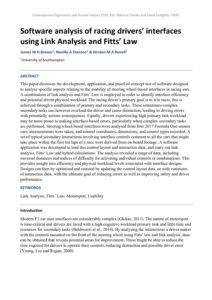| Document | Author James W H Brown, Neville A Stanton & Kirsten M A Revell |
| Abstract This paper discusses the development, application, and proof-of-concept test of software designed to analyse specific aspects relating to the usability of steering wheel-based interfaces in racing cars. A combination of link analysis and Fitts’ Law is employed in order to identify interface efficiency and potential driver physical workload. The racing driver’s primary goal is to win races, this is achieved through a combination of primary and secondary tasks. These sometimes-complex secondary tasks can however overload the driver and cause distraction, leading to driving errors with potentially serious consequences. Equally, drivers experiencing high primary task workload may be more prone to making interface-based errors, particularly when complex secondary tasks are performed. Steering wheel-based interfaces were analysed from four 2017 Formula One season cars, measurements were taken, and control coordinates, dimensions, and control types recorded. A set of typical secondary interactions involving interface controls common to all the cars that might take place within the first ten laps of a race were derived from on-board footage. A software application was developed to load this control layout and interaction data, and carry out link analysis, Fitts’ Law and hybrid calculations. The analysis revealed a range of data, including traversal distances and indices of difficulty for activating individual controls or combinations. This provides insight into efficiency and physical workload levels associated with interface designs. Designs can then by optimised and retested by updating the control layout data, or with variations of interaction data, with the ultimate goal of reducing errors as well as improving safety and driver performance. |

